Experimental Investigation into the Failure Mechanisms of Fabric Membrane Materials with Defective Flat Round Cracks
Abstract
:1. Introduction
2. Experiments
2.1. Test Settings
2.2. Test Conditions
2.3. Data Processing Methods
3. Experimental Results
3.1. Stress and Strain Results
3.1.1. Force–Displacement
3.1.2. Cases of Central Crack
3.1.3. Cases of Edge Crack
3.2. Crack Propagation
3.2.1. Central Crack Case
3.2.2. Edge Crack Working Condition
4. Discussion
4.1. Tip Stress
4.2. The Mechanic of Failure
4.3. Energy Absorption
5. Conclusions
- The crack width increases continuously during the stretching process, initially increasing rapidly. As stress increases, the crack width increment becomes small, indicating a transition to a plastic state. The crack width is directly proportional to stress, forming a function relationship. Equation (2) can be used to approximate the calculation of crack width.
- Simultaneously, during the evolution of crack width, the membrane material may undergo curling, but this curling does not affect the mechanical properties of the membrane material.
- The length of the crack increases with the increase in load, suggesting that the crack point may not always be at a fiber position but could also be at a baseline position. Once the crack point reaches a fiber position, its length no longer increases.
- As stress increases, the strain distribution of the membrane material becomes uneven, with greater strain near the crack ends. Inconsistent internal yarn deformations lead to stress concentration at the crack ends. Stress is directly proportional to strain, forming a function relationship. Equation (1) can be used to approximate the calculation of crack strain.
Author Contributions
Funding
Institutional Review Board Statement
Informed Consent Statement
Data Availability Statement
Acknowledgments
Conflicts of Interest
Abbreviations
| PVDF | polyvinylidene fluoride |
| a | the major axis of the flat circle |
| b | the minor axis of the flat circle |
| represents stress | |
| represents strain | |
| E | can be the elastic module |
| under the assumption that it is cut as an ellipse, the edge stress is represented and is expressed in Equation (3) | |
| average stress on the hole ligament | |
| the vertical length of the cut | |
| the horizontal length of the cut | |
| the width of the membrane material | |
| the energy at failure | |
| the energy of elastic |
References
- Jin, Z. Simulation Analysis and Research on the Performance of a Large-Span Inflatable Membrane Structure. Ph.D. Dissertation, Dalian Jiaotong University, Dalian, China, 2023. [Google Scholar]
- Shu, Z. Research on Air Damping under Tensioning Membrane Impact Load. Ph.D. Dissertation, Jiangsu University of Science and Technology, Zhenjiang, China, 2022. [Google Scholar]
- Yang, B.; Yu, Z.; Zhang, Q.; Shang, Y.; Yan, Y. The nonlinear orthotropic material model describing biaxial tensile behavior of PVC coated fabrics. Compos. Struct. 2020, 236, 111850. [Google Scholar] [CrossRef]
- He, R.; Sun, X.; Wu, Y.; Fu, J. Nonlinear tearing residual strength characteristics of architectural fabric membranes: A numerical and theoretical investigation. Constr. Build. Mater. 2024, 416, 135212. [Google Scholar] [CrossRef]
- Singh, G.; Bairwa, D.K.; Chattopadhyay, R.; Joshi, M.; Setua, D. Investigation on influence of time on tear behaviour of airship envelope. J. Ind. Text. 2020, 51, 5503S–5517S. [Google Scholar] [CrossRef]
- Hu, J.; Chen, W.; Qu, Y.; Yang, D. Safety and serviceability of membrane buildings: A critical review on architectural, material and structural performance. Eng. Struct. 2020, 210, 110292. [Google Scholar] [CrossRef]
- Ghosh, S. Encyclopedia of Materials: Plastics and Polymers; Elsevier: Amsterdam, The Netherlands, 2022; pp. 755–769. [Google Scholar]
- Wang, F.; Chen, Y.; Liu, G.; Gao, H.; Fu, G. Investigation of the tearing properties of a new airship envelope fabric based on experimental and theoretical methods. J. Ind. Text. 2018, 48, 1327–1347. [Google Scholar] [CrossRef]
- Chen, Y.; Li, S.; Ding, K.; Wang, F.; Fu, G. Investigation of tear strength of an airship envelope fabric by theoretical method and uniaxial tear test. J. Eng. Fibers Fabr. 2019, 14, 155892501987929. [Google Scholar] [CrossRef]
- Hohe, J.; Schober, M.; Fliegener, S.; Weiss, K.-P.; Appel, S. Effect of cryogenic environments on failure of carbon fiber reinforced composites. Compos. Sci. Technol. 2021, 212, 108850. [Google Scholar] [CrossRef]
- Chen, J.; Zhou, H.; Chen, W.; Wang, M.; Zhao, B.; Sun, W. Full-strain range characteristics of the Poisson’s ratio for coated biaxial warp-knitted fabrics under bias tensile loading. Text. Res. J. 2018, 89, 1997–2009. [Google Scholar] [CrossRef]
- Xu, J.; Zhang, Y.; Wu, M.; Zhao, Y. A phenomenological material model for PTFE coated fabrics. Constr. Build. Mater. 2020, 237, 117667. [Google Scholar] [CrossRef]
- Wang, T.; Jiang, G.; Yang, M.; Li, B. Research progress and prospects of coated fabric building membrane materials. Ind. Text. 2023, 41, 13–20. [Google Scholar]
- Skysong at ASU Campus/FTL Design Engineering Studio, 11 Aug 2009. ArchDaily. ISSN 0719-8884. Available online: https://www.archdaily.com/31562/skysong-at-asu-campus-ftl-design-engineering-studio (accessed on 26 May 2024).
- Ziqi, C.; Yingying, Z.; Junhao, X.; Xiaocheng, L.; Lanlan, Z.; Yushuai, Z. Off-axis tearing properties of the biaxial warp-knitted fabrics. Compos. Struct. 2022, 300, 116168. [Google Scholar] [CrossRef]
- Zhang, X.; Zhou, Y.; Wu, M.; Li, Y.; Bao, H. Fracture toughness of coated fabric with nonlinear tensile behaviors considered. Constr. Build. Mater. 2024, 415, 135007. [Google Scholar] [CrossRef]
- Ennouri, T.; Patricia, D.; Toan, V.K. Tear resistance of woven textiles-criterion and mechanisms. Compos. Part B-Eng. 2011, 42, 1851–1859. [Google Scholar]
- Pankow, M.; Justusson, B.; Riosbaas, M.; Waas, A.; Yen, C. Effect of fiber architecture on tensile fracture of 3D woven textile composites. Compos. Struct. 2019, 225, 111139. [Google Scholar] [CrossRef]
- Chen, J.; Chen, W.; Zhao, B.; Yao, B. Mechanical responses and damage morphology of laminated fabrics with a central slit under uniaxial tension: A comparison between analytical and experimental results. Constr. Build. Mater. 2015, 101, 488–502. [Google Scholar] [CrossRef]
- Yan, F.; Sun, G.; Xue, S. Tearing Property and Allowable Tearing Stress of PVC-Coated Polyester Fabric Membranes at High Temperature. J. Mater. Civ. Eng. 2023, 35, 04023152. [Google Scholar] [CrossRef]
- Sheng, L.; Zhang, L.; Zhang, Y.; Xu, J.; Chen, P.; Zhou, W. Tearing behavior of PVC coated fabric membrane materials under crack hole defects. J. Harbin Inst. Technol. 2024, 56, 56–63. [Google Scholar]
- Li, X. Research on Tearing Behavior of Fabric Like Building Membrane Materials Considering Central Cracks. Ph.D. Dissertation, China University of Mining and Technology, Beijing, China, 2023. [Google Scholar]
- Luo, L.; Xiang, Y.; Wang, Q. The expression for stress concentration coefficient of eccentric elliptical hole plate under tension. Appl. Math. Mech. 2012, 33, 113–124. [Google Scholar] [CrossRef]

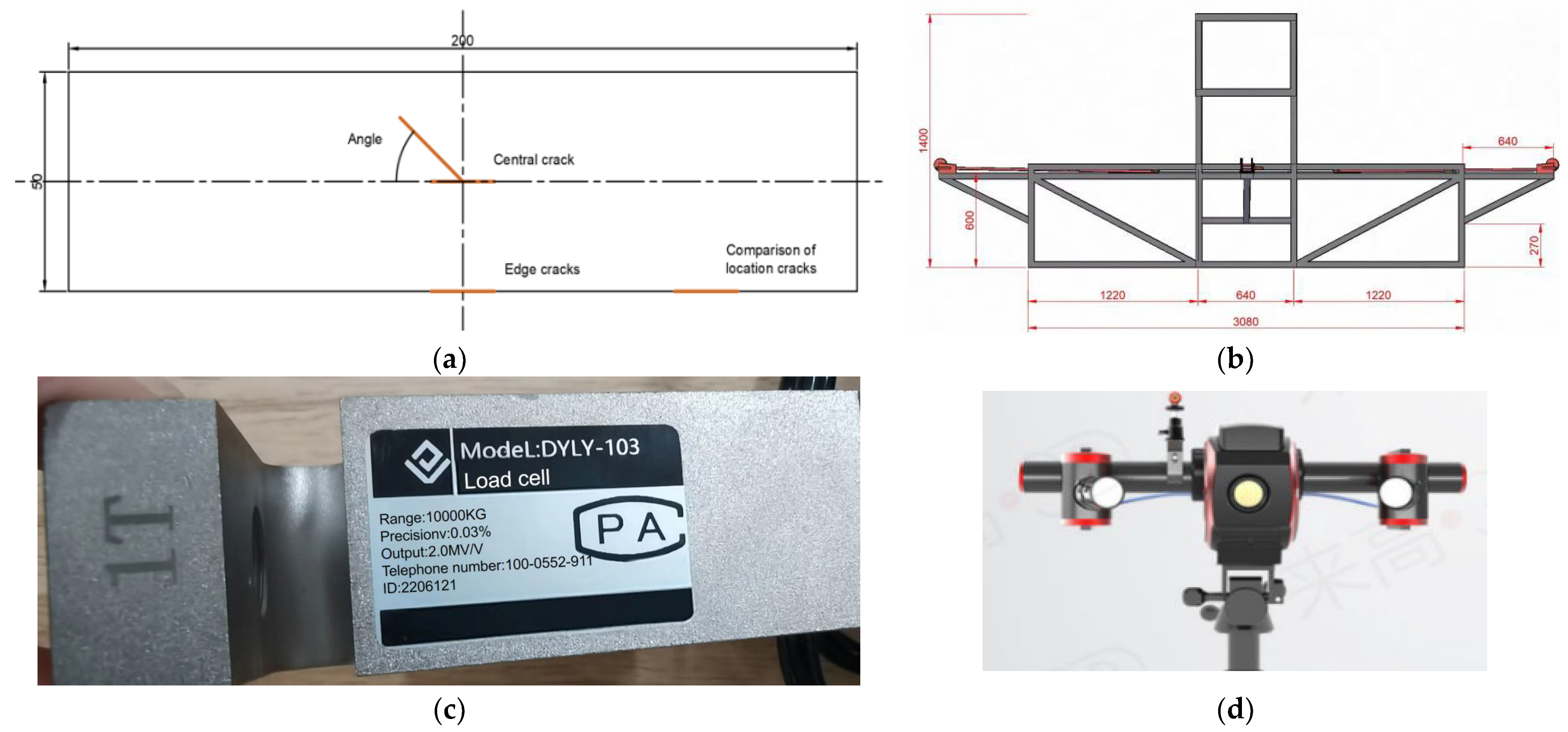



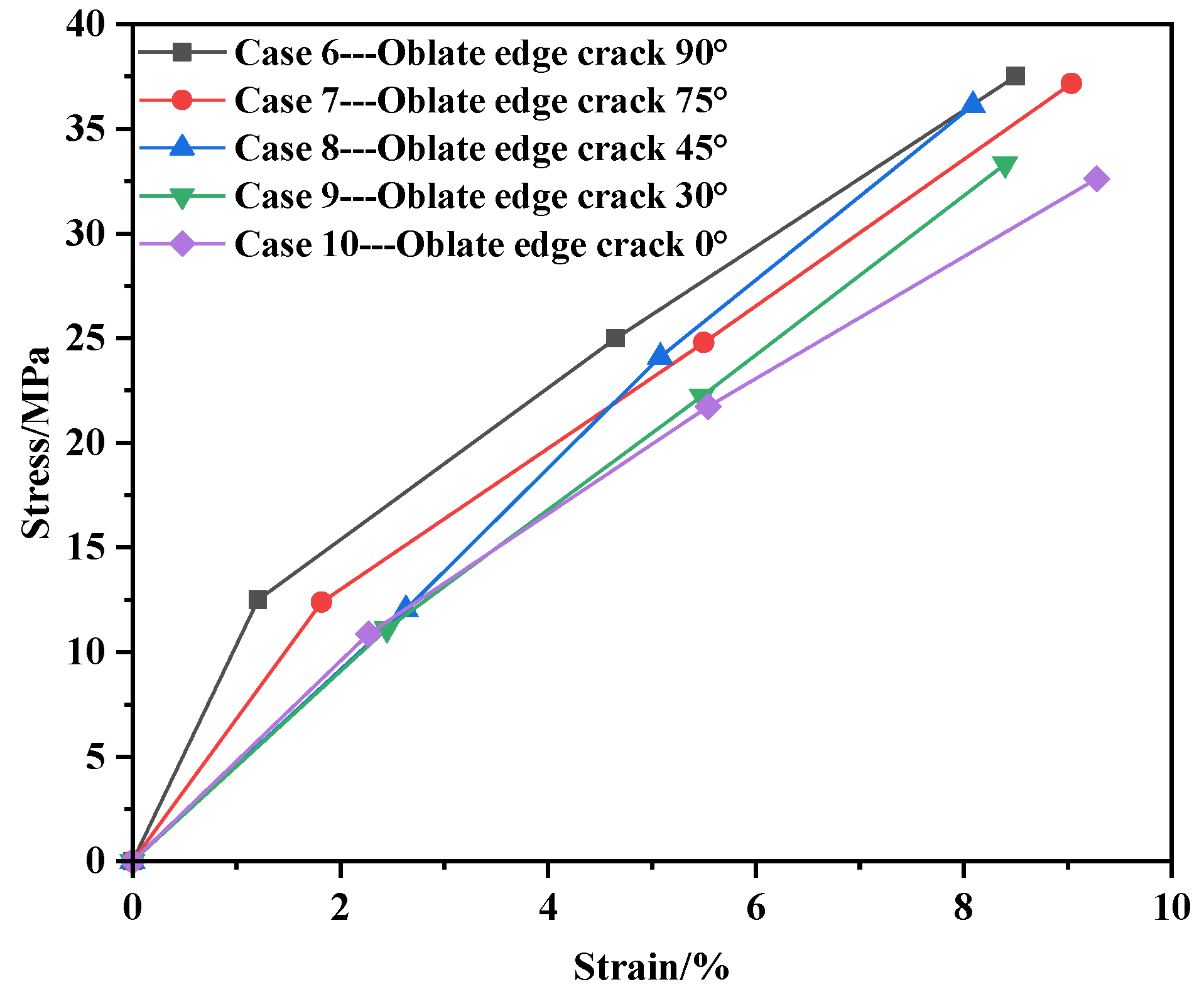

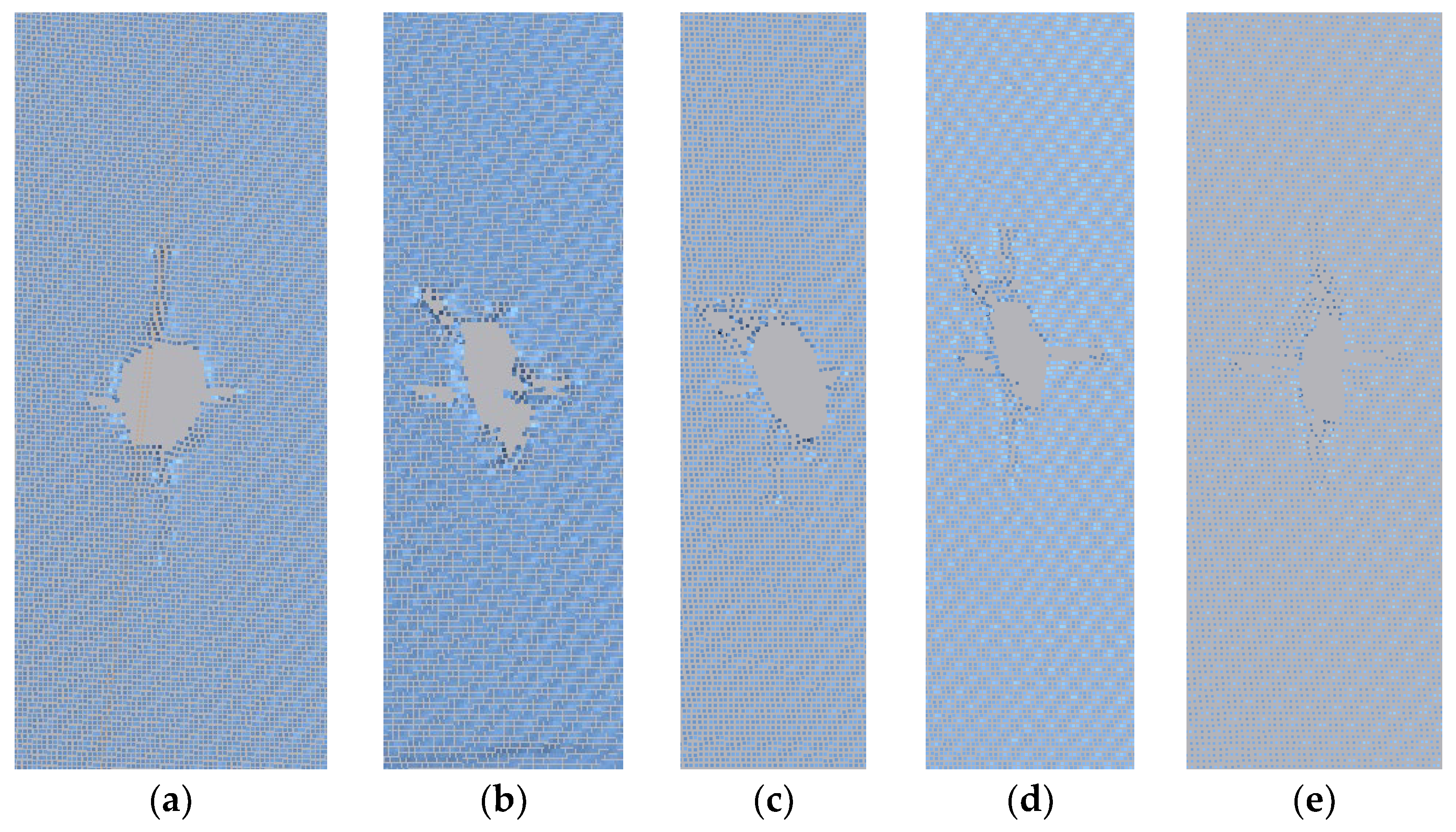



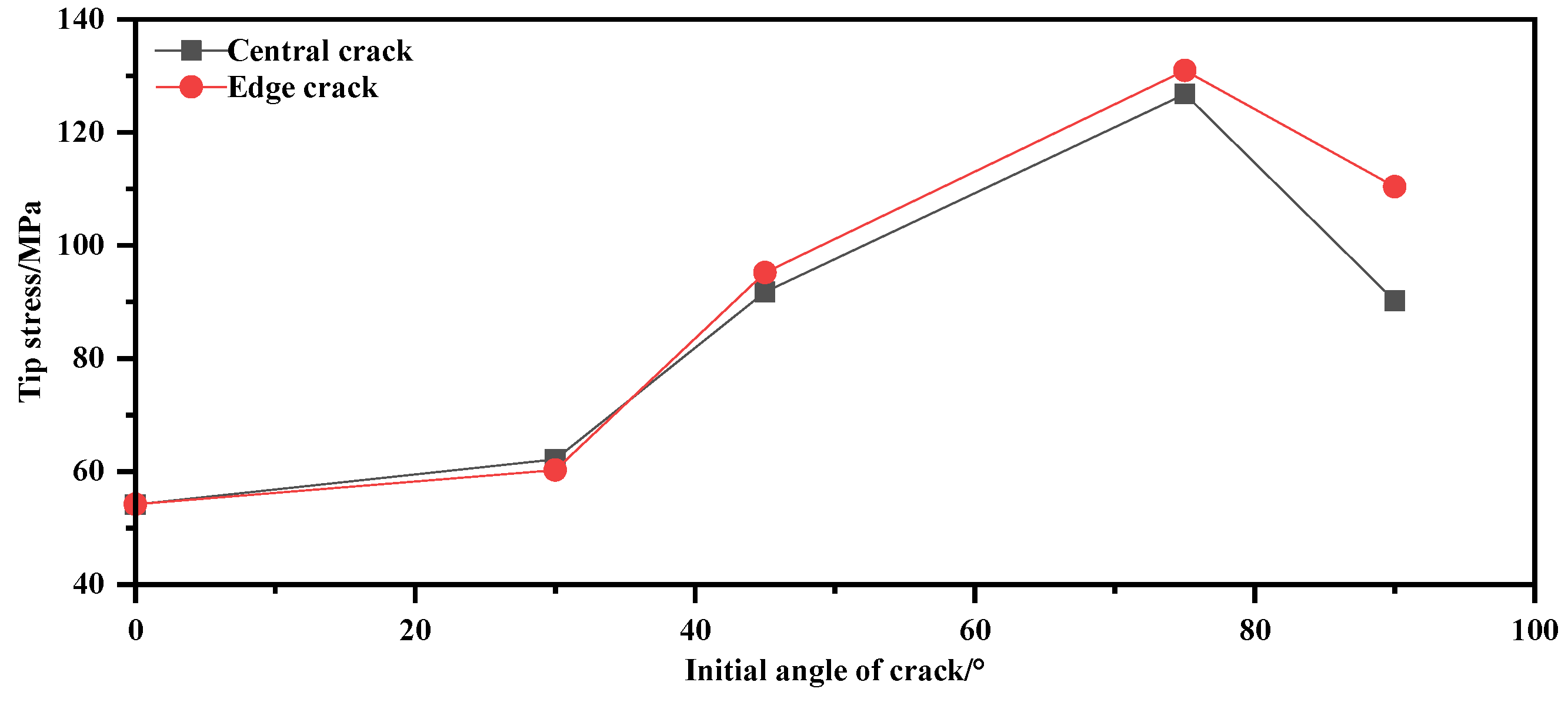
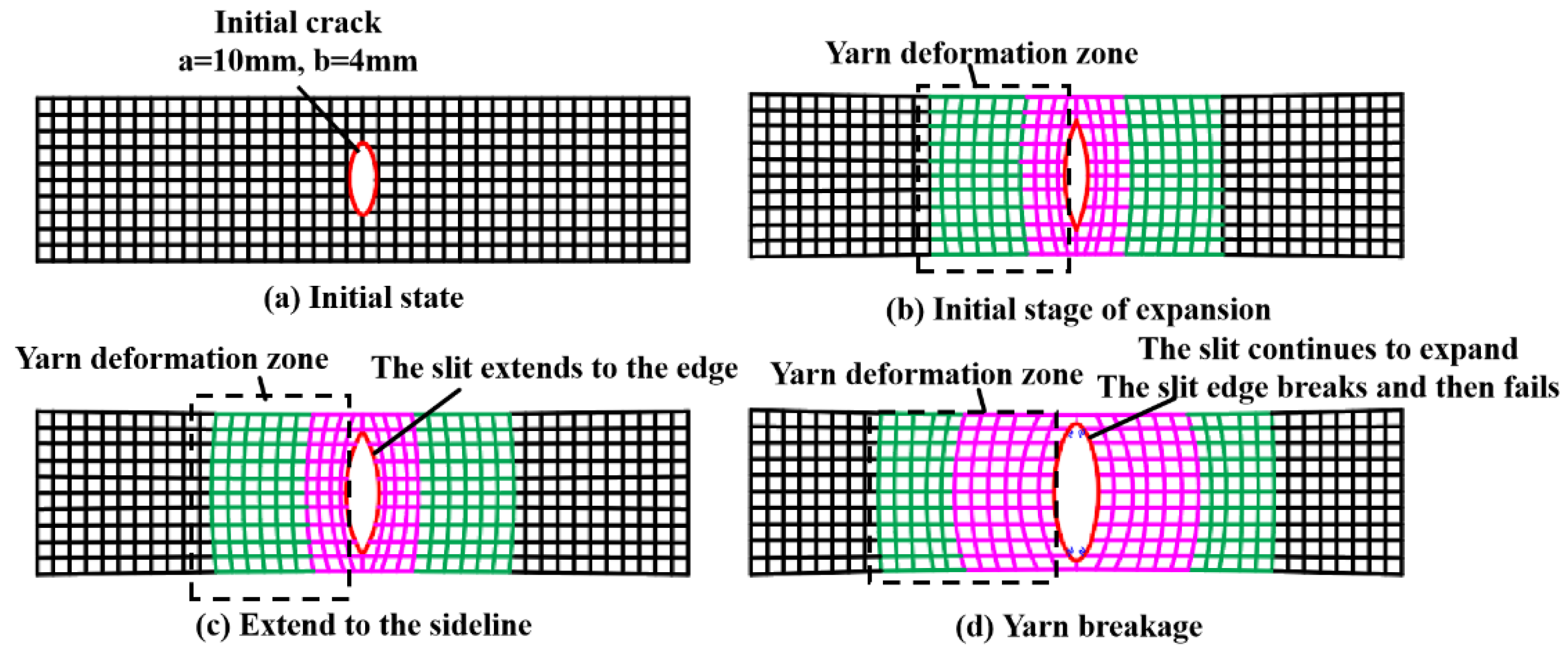

| Parameter | Type | Base Density | Elastic Module | Tension Strength | Tear Strength | Yarn Thickness | Yarn Strength |
|---|---|---|---|---|---|---|---|
| Data | PVDF | 1300 g/m2 | 430~480 MPa | 9000 N/5 cm | 550 N/5 cm | 1500 D × 1500 D | ~100 N |
| Case | Position | Crack Shape | Crack Angle | Initial Crack Length |
|---|---|---|---|---|
| 1 | Center | Oblate circle | 90° | a = 10 mm, b = 4 mm |
| 2 | Center | Oblate circle | 75° | a = 10 mm, b = 4 mm |
| 3 | Center | Oblate circle | 45° | a = 10 mm, b = 4 mm |
| 4 | Center | Oblate circle | 30° | a = 10 mm, b = 4 mm |
| 5 | Center | Oblate circle | 0° | a = 10 mm, b = 4 mm |
| 6 | Margin | Oblate circle | 90° | a = 10 mm, b = 4 mm |
| 7 | Margin | Oblate circle | 75° | a = 10 mm, b = 4 mm |
| 8 | Margin | Oblate circle | 45° | a = 10 mm, b = 4 mm |
| 9 | Margin | Oblate circle | 30° | a = 10 mm, b = 4 mm |
| 10 | Margin | Oblate circle | 0° | a = 10 mm, b = 4 mm |
| Parameter | Stress/MPa | Strain/% | ||||||||
|---|---|---|---|---|---|---|---|---|---|---|
| Load/N | 1 −90° | 2 −75° | 3 −45° | 4 −30° | 5 −0° | 1 −90° | 2 −75° | 3 −45° | 4 −30° | 5 −0° |
| 0 | 0 | 0 | 0 | 0 | 0 | 0 | 0 | 0 | 0 | 0 |
| 500 | 12.50 | 12.39 | 12.05 | 11.11 | 10.87 | 2.07 | 2.22 | 2.18 | 1.93 | 3.26 |
| 1000 | 25.00 | 24.79 | 24.10 | 22.22 | 21.74 | 4.98 | 4.55 | 4.60 | 5.12 | 5.82 |
| 1500 | 37.50 | 37.18 | 36.15 | 33.33 | 32.61 | 8.45 | 7.93 | 7.19 | 8.49 | 7.77 |
| Parameter | Stress/MPa | Strain/% | ||||||||
|---|---|---|---|---|---|---|---|---|---|---|
| Load/N | 6 −90° | 7 −75° | 8 −45° | 9 −30° | 10 −0° | 6 −90° | 7 −75° | 8 −45° | 9 −30° | 10 −0° |
| 0 | 0 | 0 | 0 | 0 | 0 | 0 | 0 | 0 | 0 | 0 |
| 500 | 12.50 | 12.39 | 12.05 | 11.11 | 10.87 | 1.21 | 1.82 | 2.63 | 2.45 | 2.27 |
| 1000 | 25.00 | 24.79 | 24.10 | 22.22 | 21.74 | 4.65 | 5.50 | 5.08 | 5.48 | 5.54 |
| 1500 | 37.50 | 37.18 | 36.15 | 33.33 | 32.61 | 8.50 | 9.04 | 8.09 | 8.40 | 9.28 |
| Parameter | Stress/MPa | Crack Length/mm | ||||||||
| Load/N | 1 −90° | 2 −75° | 3 −45° | 4 −30° | 5 −0° | 1 −90° | 2 −75° | 3 −45° | 4 −30° | 5 −0° |
| 0 | 0 | 0 | 0 | 0 | 0 | 9.80 | 9.29 | 9.97 | 9.20 | 9.86 |
| 500 | 12.50 | 12.39 | 12.05 | 11.11 | 10.87 | 9.82 | 9.93 | 10.03 | 10.02 | 11.18 |
| 1000 | 25.00 | 24.79 | 24.10 | 22.22 | 21.74 | 10.41 | 10.91 | 10.63 | 11.35 | 11.63 |
| 1500 | 37.50 | 37.18 | 36.15 | 33.33 | 32.61 | 10.99 | 11.89 | 10.92 | 13.35 | 12.51 |
| Parameter | Crack Width/mm | Vertical Displacement of Cracks/mm | ||||||||
| Load/N | 1 −90° | 2 −75° | 3 −45° | 4 −30° | 5 −0° | 1 −90° | 2 −75° | 3 −45° | 4 −30° | 5 −0° |
| 0 | 4.04 | 3.82 | 3.56 | 3.53 | 3.68 | / | / | / | / | / |
| 500 | 5.25 | 4.48 | 4.28 | 4.48 | 4.09 | 1.20 | 0.68 | 1.14 | 0.36 | |
| 1000 | 7.40 | 5.59 | 5.28 | 5.13 | 4.28 | 1.67 | 0.85 | 1.02 | 0.45 | |
| 1500 | 9.33 | 6.48 | 5.74 | 6.26 | 4.90 | 1.68 | 0.99 | 1.11 | 0.86 | |
| Parameter | Stress/MPa | Crack Length/mm | ||||||||
| Load/N | 6 −90° | 7 −75° | 8 −45° | 9 −30° | 10 −0° | 6 −90° | 7 −75° | 8 −45° | 9 −30° | 10 −0° |
| 0 | 0 | 0 | 0 | 0 | 0 | 8.78 | 10.11 | 8.36 | 9.60 | 9.72 |
| 500 | 12.50 | 12.39 | 12.05 | 11.11 | 10.87 | 9.15 | 10.54 | 9.87 | 10.49 | 9.99 |
| 1000 | 25.00 | 24.79 | 24.10 | 22.22 | 21.74 | 9.30 | 11.68 | 9.99 | 11.15 | 11.48 |
| 1500 | 37.50 | 37.18 | 36.15 | 33.33 | 32.61 | 9.97 | 13.13 | 11.00 | 11.69 | 13.25 |
| Parameter | Crack Width/mm | Vertical Displacement of Cracks/mm | ||||||||
| Load/N | 6 −90° | 7 −75° | 8 −45° | 9 −30° | 10 −0° | 6 −90° | 7 −75° | 8 −45° | 9 −30° | 10 −0° |
| 0 | 3.67 | 3.85 | 3.93 | 3.78 | 3.77 | / | / | / | / | / |
| 500 | 4.33 | 4.12 | 4.40 | 4.35 | 4.47 | 0.98 | 0.71 | 1.08 | 1.06 | |
| 1000 | 5.29 | 5.01 | 4.79 | 5.36 | 4.80 | 1.22 | 0.94 | 1.11 | 1.24 | |
| 1500 | 6.49 | 6.66 | 5.45 | 5.99 | 5.24 | 1.38 | 1.01 | 1.13 | 1.28 | |
| Parameter | Central Crack Condition/MPa | Edge Crack Working Condition/MPa | ||||||||
|---|---|---|---|---|---|---|---|---|---|---|
| Case Angle | 1–90° | 2–75° | 3–45° | 4–30° | 5–0° | 6–90° | 7–75° | 8–45° | 9–30° | 10–0° |
| 0 | 0 | 0 | 0 | 0 | 0 | 0 | 0 | 0 | 0 | 0 |
| 500 | 42.77 | 50.44 | 35.44 | 21.65 | 17.71 | 47.70 | 55.90 | 34.49 | 22.42 | 19.18 |
| 1000 | 68.54 | 89.98 | 63.61 | 42.69 | 35.45 | 82.40 | 101.69 | 65.61 | 41.49 | 37.13 |
| 1500 | 90.18 | 126.76 | 91.74 | 62.16 | 54.16 | 110.37 | 130.95 | 95.17 | 60.24 | 54.21 |
Disclaimer/Publisher’s Note: The statements, opinions and data contained in all publications are solely those of the individual author(s) and contributor(s) and not of MDPI and/or the editor(s). MDPI and/or the editor(s) disclaim responsibility for any injury to people or property resulting from any ideas, methods, instructions or products referred to in the content. |
© 2024 by the authors. Licensee MDPI, Basel, Switzerland. This article is an open access article distributed under the terms and conditions of the Creative Commons Attribution (CC BY) license (https://creativecommons.org/licenses/by/4.0/).
Share and Cite
Li, W.; Liu, P.; Zhang, J.; Kaewunruen, S. Experimental Investigation into the Failure Mechanisms of Fabric Membrane Materials with Defective Flat Round Cracks. Materials 2024, 17, 2970. https://doi.org/10.3390/ma17122970
Li W, Liu P, Zhang J, Kaewunruen S. Experimental Investigation into the Failure Mechanisms of Fabric Membrane Materials with Defective Flat Round Cracks. Materials. 2024; 17(12):2970. https://doi.org/10.3390/ma17122970
Chicago/Turabian StyleLi, Wenrui, Ping Liu, Jiancheng Zhang, and Sakdirat Kaewunruen. 2024. "Experimental Investigation into the Failure Mechanisms of Fabric Membrane Materials with Defective Flat Round Cracks" Materials 17, no. 12: 2970. https://doi.org/10.3390/ma17122970






